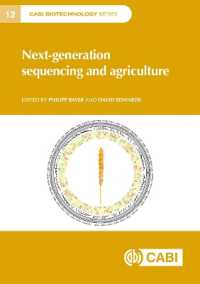- ホーム
- > 洋書
- > 英文書
- > Science / Mathematics
Full Description
Guide to Techniques in Mouse Development, Part B, is an authoritative guide to different methods used in enzymology, focusing on investigating mouse development using technological advances. The text provides information regarding the principles of the methods in mouse development, and it offers readers reliable experimental protocols and recipes described comprehensively by leaders in the field of enzymology.
The text is divided into three sections and organized into 25 chapters. Below are several concepts covered by the text:
Lentivirus transgenesis o Germline modification using mouse stem cells
Electroporation
Applications of transposons in mouse genetics
Functional genomics using transposon systems
The use of DNA transposons in detecting cancer genes in mice
Recombination, conditional mutagenesis and induction of tamoxifen
Genetic fate mapping using recombinases
Genetic screens mouse ES cells
Gene trap mutagenesis
Mouse mutagenesis
Self- renewal and pluripotency
Transgenic RNAi applications
Gene knockdowns
Tetracycline-controlled transcription
Gene expression profiling of mouse embryos
The book is a comprehensive guide for students and professionals in genetics, cytology and molecular biology, who will find this book invaluable for their learning and practice.
Contents
Section I. Transgenesis1. Lentivirus transgenesis2. Germline modification using mouse spermatogonial stem cells3. Embryonic in vivo electroporation in the mouse
Section II. Transposons4. Current applications of transposons in mouse genetics5. Functional genomics in the mouse using the Sleeping Beauty transposon system6. The use of DNA transposons for cancer gene discovery in mice
Section III. Recombinases7. A practical summary of site specific recombination, conditional mutagenesis, and tamoxifen induction of CreERT28. A recombineering pipeline to make conditional targeting constructs 9. Confirmation of recombination site functionality in gene targeting vectors using recombinase-expressing bacteria10.Genetic fate mapping using site-specific recombinases11. Mapping cell fate and function using recombinase-based intersectional strategies
Section IV. Mutagenesis12. Genome-wide forward genetic screens in mouse ES cells13. Gene trap mutagenesis in the mouse14. A wider context for gene trap mutagenesis 15. Mouse mutagenesis with the chemical supermutagen ENU16. Phenotype-driven mouse ENU mutagenesis screens17. Using ENU mutagenesis for phenotype-driven analysis of the mouse
Section V. Gene Knockdowns18. Exploration of self-renewal and pluripotency in ES cells using RNAi19. Transgenic RNAi applications in the mouse 20. Gene knockdown in the mouse through RNAi21. In vivo analysis of gene knock-down in tetracycline-inducible shRNA mice22. The power of reversibility: Regulating gene activities via tetracycline controlled transcription
Section VI. Gene Expression Profiling23. Gene expression profiling of mouse oocytes and preimplantation embryos24. Interrogating the transcriptome of oocytes and preimplantation embryos25. Gene expression profiling of mouse embryos with microarrays








